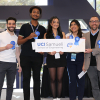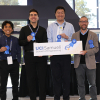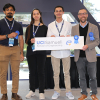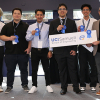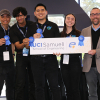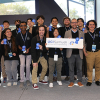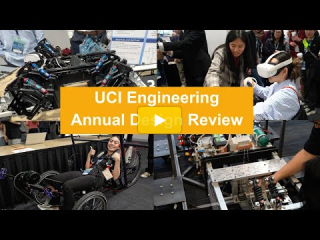Twelve Senior Design Projects Win Dean’s Choice Awards
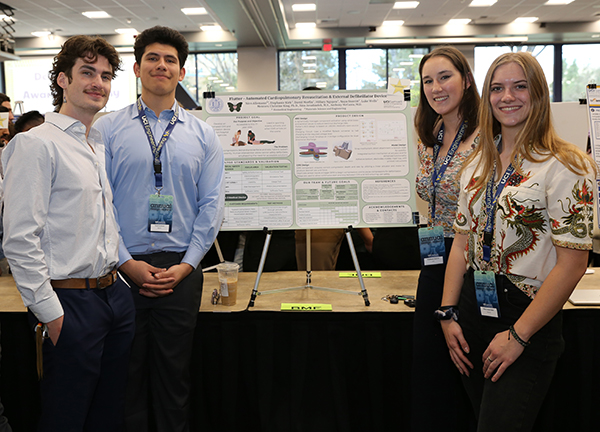
April 10, 2024 - The UC Irvine Student Center brimmed with excitement as engineering students presented 200 senior design projects at the Samueli School’s Annual Design Review on Friday, March 15. Over 125 registered guests including industry professionals, engineering alumni, staff and student family members came to support the seniors from all six engineering departments who presented their projects, answered questions and networked.
The senior design program provides students with hands-on learning experience and professional development through innovative projects that bridge academic fundamentals with real-world challenges. After working in teams on their projects for two quarters, students then present their ideas by displaying or demonstrating them to a wider audience at Annual Design Review.
“Annual Design Review is a public-facing event so faculty, staff and industry professionals are all part of this special Anteater engineering gathering,” said Dean Magnus Egerstedt, addressing the student presenters. “You all worked hard and learned a lot, and this is your chance to show it.”
Projects spanned many areas of engineering, and students presented creative ideas and solutions such as AI-controlled drone technology, a compression-free neck brace, alternative designs for the I-5 Ortega Highway interchange and an amplifier designed for the organ. Many teams d

isplayed prototypes for guests to interact with including hologram chess, an automatic waste-sorting trash bin and lidar-based self-driving technology demonstrated on a model truck.
“This is our first year with a functioning prototype so we’re very excited to present it,” said Human Powered Vehicle team member Wilson Huang. “We are competing this spring against other schools, but having the prototype is an accomplishment in itself.”
Stephen Palm ’87, an architect and distinguished engineer at semiconductor manufacturing company Broadcom, has attended the event for several years and said student team responses to his questions were even better this year. “The projects were practical, which benefits students who will soon enter the workforce, and hopefully, students were encouraged to hear their current work will be directly relevant.”
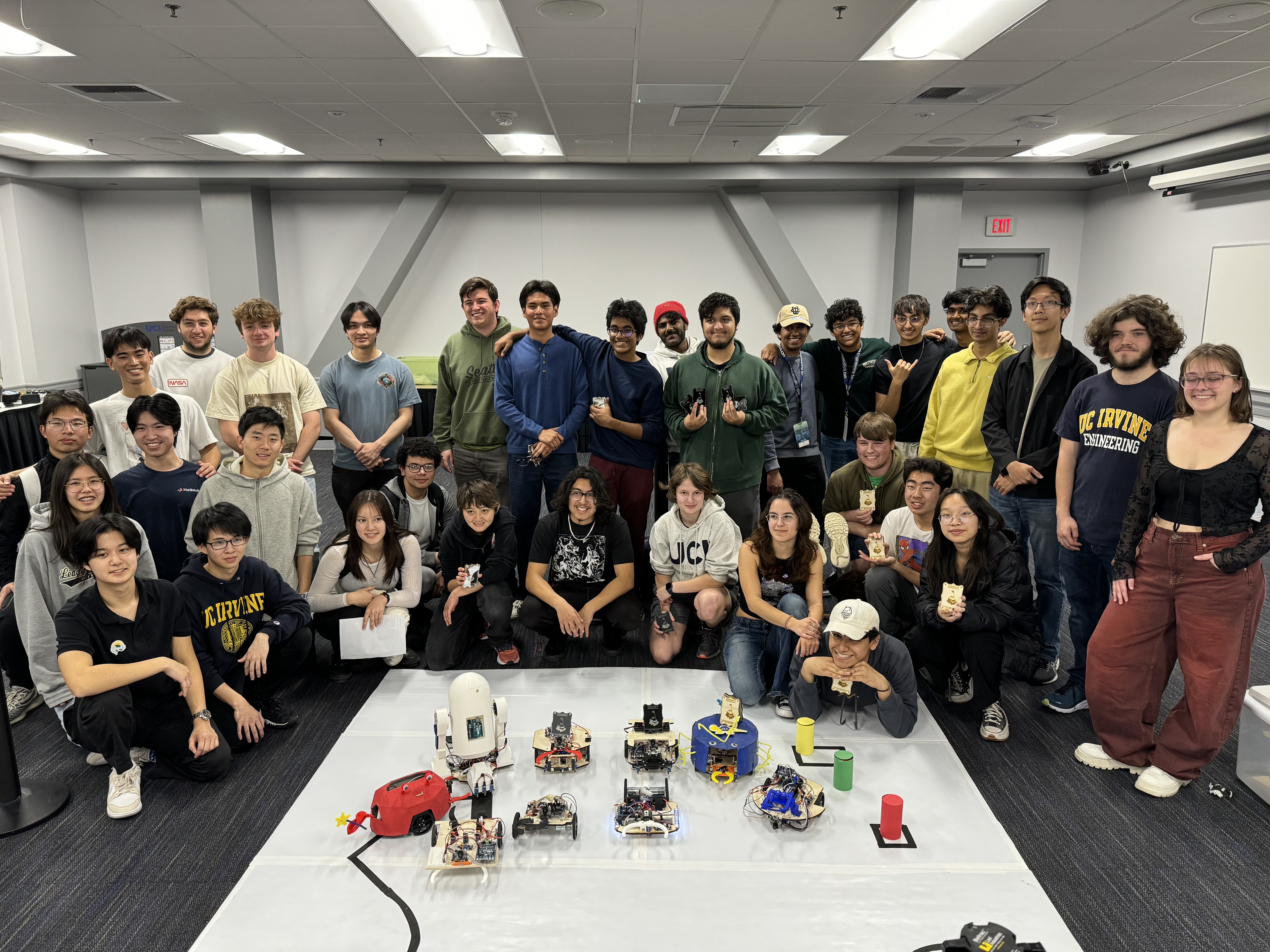
The fall quarter’s introductory engineering course for first-year students held its annual autonomous rover competition at the event as well. The top 10 teams from the course participated, and each member from the three winning teams received a medal engraved with the outline of a Zot Bot, UCI’s food-delivery rovers. Team Perzeverence won first place, Roomba II earned second and Renegade Roombas took third.
Culminating the two-hour event was the announcement of the Dean’s Choice Awards. This year, Dean Egerstedt selected 12 projects from 28 nominations. With input from each department and from a group of graduate students, he judged projects based on three criteria: the importance of the addressed problem, the maturity of the project and the wow factor. Here are this year’s winners, in alphabetical order by department.
BIOMEDICAL ENGINEERING
NeoMold: A 3D-Printed Customizable Ear Mold for Congenital Ear Differences in Neonates
This project is a 3D-printed, nonsurgical ear mold for infants with outer ear deformities. While current solutions are typically expensive and not customizable, this team aims to create an inexpensive, custom-fit mold that is easy to use for those without medical training to provide better accessibility to treatment, especially in underserved communities.
Team members: Christine Ly, Kathy Duong, Christine Nguyen, Frida Sandoval
Cameras currently used in law enforcement and healthcare settings to detect skin-based evidence of abuse are more accurate on light skin. This project uses multispectral imaging techniques to develop an imaging tool for reliably detecting bruises on any skin tone.
Team members: Ashley Im, Alejandra Reyes Chavoya, Mitchell Frazeur, Hao Ngo
CHEMICAL AND BIOMOLECULAR ENGINEERING
Process Control for System Temperature
This team focused on determining the best controller type for managing the system temperature in chemical engineering operations and manufacturing processes. They manually altered tuning parameters to optimize response time, offset elimination and minimize settling time and oscillations in proportional-integral-derivative (PID) controllers, a control loop mechanism.
Team members: Ken Chih, Varun Sridhar, Adalberto German-Garcia, Juan-Antonio Orozco, Braulio Armenta
CIVIL AND ENVIRONMENTAL ENGINEERING
Zooming to México on the Siempre Viva Bridge
This team worked with Caltrans Bridge Design group to design a two-span, cast-in-place prestressed concrete bridge over California State Route 11. Their goal is to enhance mobility between San Deigo and Baja California and reduce border wait times.
Team members: Bryan Perez (project manager), Isaiah Hernandez, Vinh Vu
Industry advisers: Mina Pezeshpour, Peyman Kaviani, Cesar Sanchez, Reza Mortezaie, Ahmed Nasr (Caltrans)
This team is designing various building assemblies with unique structural concepts to create small event spaces for students that have minimal impact on the preexisting ecosystem. The designs combine artificial intelligence and biobased materials to reduce carbon usage.
Team members: Saghar Rafiee, Valeria Borroel, Mathewos Berache, Marc Ayoub
Industry advisers: James Bucknam, Brett Kaufmann (PJHM)
ELECTRICAL ENGINEERING AND COMPUTER SCIENCE
Magnetic Actuators for Haptic Feedback in Virtual Reality Applications
This project uses magnetic actuators to create dynamic haptic feedback and touch sensations in virtual reality settings. The physical interaction simulation they are refining can be applied in entertainment, as well as medical training and physical therapy.
Team members: Alexandra Zhang Jiang, Tony Liu, Rachel Villamor, Derek Cha
This team’s goal is to provide a low-cost tool for students to enhance academic performance and reduce stress via environmental controls. The tool employs facial detection and pulse monitoring to determine the color and brightness of light and type of music suitable for the user to optimize academic performance and mental well-being.
Team members: Cristian Chun Yoxon, Miguel Angel Guzman, Ryan Ho Wong
Biometric Advanced Driver Assistance System
This project uses machine learning to sense and warn drowsy and stressed drivers to take a break. It reads physical signs such as breathing and heart rate and aggressive and defensive driving behavior to analyze the driver’s risk.
Team members: Ismail Bayoumi, Citlali Rodriguez, Rithvik Tirumala
MECHANICAL AND AEROSPACE ENGINEERING
This team designed a smart home lock system using a discreet device that can transmit the lock status of a door to a smartphone application. They aim to offer a small, secure device at a low cost that is consistent in appearance with a traditional lock.
Team members: Criss Hossam Azer Habashi, Edward Leija, Lucas Lin, Brady Muramoto, Daniel Stoll
This team created an electric motor-assisted trike for the American Society of Mechanical Engineers Human Powered Vehicle Challenge with a top speed of 29.6 mph at 100 rpm. Key features include an adjustable seat, rollover cage and emergency brakes.
Team members: Angelo Ilagan (chief engineer), Christian Mason (project manager), Sophia Shannon (project manager), Jeffery Lasher (dynamics lead), Gabriel Sackinger (statics lead), Aviraj Singh (electrical lead), Rogel Aguilar, Jason Dick, Naethan Fajarito, Albert Huang, Wilson Huang, Sunny Lin, Ethan Macias, Steven Mejorado, Ocean Mou, Henry Nguyen, Jacob Pham, Neal Purohit, Matthew Quach
This project focuses on a sustainable, fast transportation alternative called the Hyperloop, an electromagnetically propelled and magnetically levitated pod that can travel up to 670 mph. The team aims to build a small-scale version of the Hyperloop pod.
Team members: Jacob Antony, Anthony Chin, Allen Hsing, Christopher Whaley, Kaitlyn Nguyen, Marc Haddad, Ryan Mawlawi, Crew Parker, Dillon Kim, Rachael Koo, Daniel Pena, Harbour Li, Jefferson Ng, Aaron Eslava, Brigitte Chung, Chuong Tran, Max Stark, Angelina Licos, Calvin Kang, Ryan Quach, Andrew Traguer, Angel Diaz, Brian Chau, Riya Goja, Rye Scholin, Taesung Hwang, Sam Der, Syona Mehra, Vrushang Anand, Tim Ngo, Josh Nguyen, Nicol Veloya
Interns: Kaydi Nomura, Oscar Ning, Michelle Ko, Diego Solorzano
MATERIALS SCIENCE AND ENGINEERING
This project aims to create a cheaper, frictionless alternative to dental crowns. Their goal is to pioneer a more effective form of dental restoration by applying a tantalum functional gradient coating to yttria-stabilized zirconia.
Team members: Jasmine Brizuela, Nam de Porceri, Steve Ho, Megan Huynh, Scott Kiehn
– Lilith Christopher





